
You are reading the older HTML site
Positive Feedback ISSUE
may/june 2008
audio crafters guild
1000 control amplifier
as reviewed by Mike Wechsberg
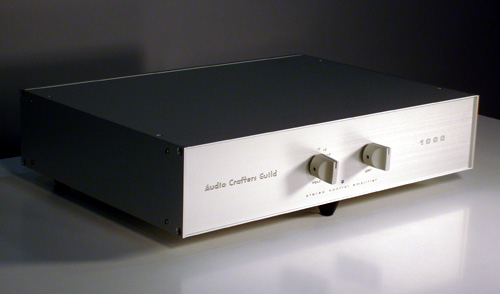
|
MIKE WECHSBERG'S SYSTEM
LOUDSPEAKERS
ELECTRONICS
SOURCES
CABLES
|
Fellow audiophiles, our hobby is expensive! Have you noticed the prices on some of the latest high-end gear? Power amps and preamps are pushing $100,000. Speaker manufacturers stumble over each other to produce the most expensive "statement" product at prices over $200,000, $300,000, even $400,000. Some turntables and tonearm combinations over $100,000, and even CD players, which we read will soon be obsolete, are over $50,000. Who buys this stuff? Is it drug dealers, crime bosses, greedy corporate CEOs, plastic surgeons, basketball players, my plumber? I know some of it goes to audio reviewers who benefit from "industry accommodation" pricing, but we're a small group. I just don't understand where the market is, but I guess it's there or the manufacturers would not be producing so many high cost components. Most of us audiophiles can only drool over the reviews of this gear in the magazines (or slobber over our keyboards if e-centric), but to actually acquire state-of-the-art sound at an affordable price is an elusive goal. That is why I was so pleased to receive the Audio Crafters Guild 1000 Control Amp for review. The company credo is to "deliver 95% of the performance and style of cost-no-object audio systems at 20% of their cost." Well, I don't know if they got all the way to 95% with the 1000 Control Amp, but they come pretty close, especially if you associate audio performance with the ability to feel and enjoy the music. They did get the 20% price right for sure.
The 1000 Control Amp (I'll call it "the 1000" from here forward) is a very flexible and powerful component that has outstanding audio performance. As a stereo amplifier it produces 525W per channel into 8 ohms, and 1100W into 4 ohms. Anything over a 2 ohm load can be driven. It also has a resistive stepped attenuator that allows the amp to be used as a passive preamp as well. Four line level inputs can be accommodated. The 1000 also has a pair of level-controlled outputs to drive a subwoofer or another amplifier for bi-amping purposes. Alas, no line level recording output, mute button, phase switch or headphone jack, but these are not important to most users. The astonishing thing is that this high power and generous feature set is available by mail order from beautiful Tulsa, OK for just $3750. Perhaps even more astonishing, the amp weighs just 9 lbs.
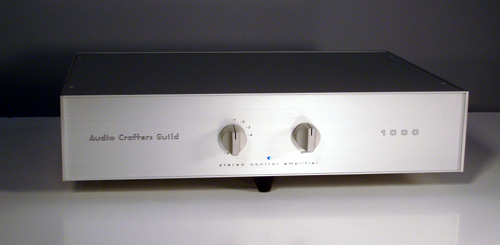
How is so much power packed into such a lightweight package? The answer is class D operation. Now stay with me here, don't hit the page down button just yet. "D" does not stand for "Digital". Many of you know that class D amplifiers are analog amplifiers that use switching transistor technology instead of linear transistor technology to achieve voltage gain. The concept has been around for several decades and there are a number of different implementations, but only in the last 10 years or so have the transistors and associated circuit techniques gotten good enough to meet the standards of high-end audio. There are more than a dozen brands of high-end class D audio amplifiers on the market today from such well-known names as PS Audio, Carver, Cary Audio, Kharma, Jeff Rowland, Audio Research and others. Other class D or switching amps are all around us in many home theater systems, lots of subwoofers, plenty of automobile sound systems and much of pro audio today. Class D amplifiers are much more efficient in converting wall plug power into audio power at the speaker terminals. This eliminates the need for large and heavy heat sinks or forced air-cooling that add significant cost and weight to many of the solid-state amplifiers we are accustomed to. In addition, they are very "fast" supporting good dynamics and transient response. According to Norm Tracy at Audio Crafters Guild "the reason we are used to seeing banks of beer can sized capacitors in linear power amp supplies is those supplies are limited to running at line frequency of 50 or 60 Hz. When current is sent to the speaker a 60 Hz supply has to wait for the diode bridge to turn on once every 1/60th of a second to replenish the supply rail. The big caps are there to try and store enough current to hold the rail up until the bridge diodes can turn on again. And all this is happening right dab smack in the middle of the audio band at 50 or 60 Hz. In contrast an audio quality switching supply is running at 100s of kilohertz, well above the audio band. As current is metered out to the load the PWM [pulse width modulation) feedback loop around the supply reacts in less than 1/100,000 of a second to maintain the rail voltage. So we get cost less to buy and operate and better sounding music. That is what I call a win, win, win situation."
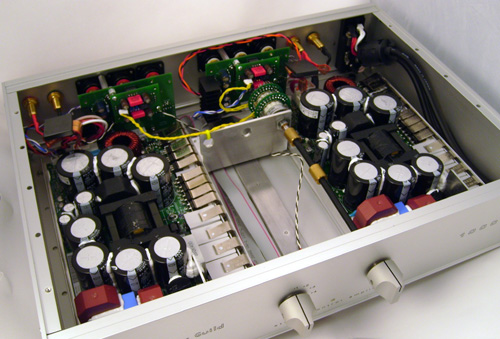
Most of high-end class D amplifier makers use amplifier modules from one of three suppliers who own patents on some of the basic technology. ACG uses the ICEpower® technology from Bang & Olufsen. B&O is known for their artistically unique industrial designs, but they also have some terrific engineers who understand both audio fundamentals and musicality. The 1000 uses the most powerful of several ICEpower® modules available from B&O in order to gain the benefit of the heftiest power supply. ACG adds a separate external energy storage box that is said to improve macro and micro dynamics (additional $995). This energy pack is connected to the main amplifier by two short umbilical cables. I tested the amp only with the energy pack and I wouldn't want to be without it. ACG installs two power modules in a common chassis with a ganged volume control, but otherwise the design is dual mono all the way. Other brands using the same ICEpower® modules, such as Red Dragon, sell the amplifier as a monoblock. Although the same amplifier module is used by several manufacturers, each amplifier designer still has many choices to make in configuring the complete amplifier. These choices can affect the sound in many ways.
ACG states their goal is not only to achieve 95% of the performance of the best audio amplifiers but also to match 95% of their style. On this account ACG does not do as well. Although the external appearance of the 1000 chassis looks nice (it's available either in black or brushed aluminum—I had the latter), compared to the cost-no-object designs it's pretty flimsy. The top and bottom plates are thin and the whole affair is held together with small screws. Although cone feet are used there is no particular attention paid to dampening resonances. I wanted to put a heavy weight on top of the amp to see if vibration effects were audible, but I was afraid of bending the sheet metal. Inside, the amplifier modules are connected to the inputs, outputs, volume control and selector switch via several small plastic connectors. I learned all about these in fixing a connection that came loose during shipping. ACG was probably stuck with these because they are part of the B&O design, but a better means to secure the connectors and damp vibration should be considered. The inputs, outputs and speaker terminals are all of excellent quality. ACG shows they spend the money where they think it's best spent. The front panel stepped volume control and source selector are also good parts but don't have that silky feel that comes with most mega-buck products. I give the 1000 about a 60 for style, but that's a small factor considering the low price and exemplary sonic performance.
Setup
I hooked up the 1000 initially as a replacement for the power amp in my system. That is, I took the output from my Audible Illusions III preamp into one of the 1000 inputs and set the volume control on the amplifier at mid range. After allowing everything to warm up and play for a couple of hours (the unit was already broken in when I received it) I sat down for a first time listen. I was very pleased with what I heard except the low end seemed strangely exaggerated and lumpy and the deep lows, provided by my powered Velodyne subwoofer, were missing. I suspected some kind of interaction with my MIT Terminator speaker cables, which contain an in-line frequency tailoring network. So, I swapped out the MIT speaker cables with some Audioquest and Granite cables that I had on hand. This seemed to smooth out the bass response some but it was still stronger than I'm accustomed to. I rolled out my low bass test recordings and my Radio Shack sound level meter and re-calibrated the volume level on the Velodyne subwoofer. This resulted in a more natural balance, but I ultimately decided to turn off the subwoofer to give the amplifier the fairest test. My Wilson Cub speakers are only flat down to about 55 Hz, but with the apparent bass boost provided by the 1000 and the added room response the low frequencies sounded just fine without the subwoofer. Only the real low organ and string bass on some classical recordings seemed light, but just about everything else in the bass seemed very dynamic and solid, including the hall sound on some of my best classical recordings.
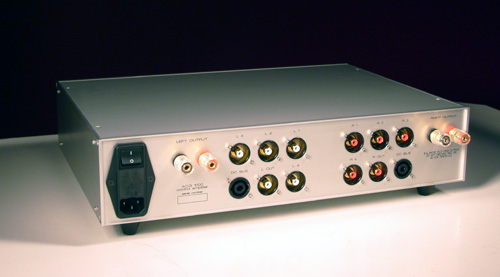
The high frequency performance of the 1000 was affected significantly by the interconnects that I used. My room is set up in such a way that I use long interconnects from the preamp to the power amp which is located in between the two speakers. I normally use 20-foot Audioquest Cobra interconnects that seem to work well with my Krell KAV-2500 amp and the preamp. During these initial fine tuning steps I found the sound to be a little too dark and the imaging a bit indistinct. I substituted some MIT Terminator2 interconnects for the Audioquest. Whereas the MIT speaker cables had a problem with this amp, the same brand interconnects worked really well. The upper end response was a shade smoother and the soundstage in particular became wider and deeper. Imaging was more focused as well. I used the MIT interconnects for the remainder of my listening. There were two stages of this listening experience; one with the Audible Illusions preamp in line and a second with my CD/SACD player plugged directly into the 1000 and using the 1000 as a passive preamp as well as a power amp. In between listening sessions I left the 1000 turned on most of the time as it consumes only 16W in standby mode.
Listening
The first thing I noticed upon listening to the 1000 was its terrific macro and micro dynamics. I found this very appealing, as dynamics are one of the chief differences between recordings and real music. In fact the dynamic contrasts in the bass produced by the 1000, sometimes called bass slam, is about as good as I've ever heard. Second, the 1000 is really good with both male and female vocals. Male singers like Aaron Neville and Johnny Cash on good recordings sound especially strong and realistic, but female vocals also come across very well.
Probably the best characteristic of this amplifier is its ability to communicate drama and emotion in all the types of music I tried. So many other amplifiers are very good at reproducing what is in the record groove (or the "pits" if it's a CD) without really communicating the message. My current reference amplifier, the Krell KAV-2500 is more of a "reproducer" whereas the ACG is more of a "communicator." Given a choice I would go with the "communicator" every time.
Let's run down the performance of the ACG 1000 from bottom to top. I've already mentioned the outstanding performance of the 1000 in the bass. The lows are full, tight and explosive, and this performance extends up into the mid bass range. The low frequency response may even be lifted a tad from flat. I should caution that I could not evaluate the lowest octaves as my speakers, the Wilson Cubs, really only respond to around 50 Hz, but the ACG seemed to add half an octave of bass to their performance such that I could enjoy them fully sans subwoofer.
The midrange of the 1000 is as flat as can be with no added warmth. It portrayed the sound put into it without alteration. When listening through my Audible Illusions tube preamplifier I was able to hear the characteristic warmth of the preamplifier, but when I listened without the preamp, with my CD player plugged directly into the ACG amplifier some of that warmth disappeared but the dynamics increased in its place. Piano, strings, woodwinds strong in midrange frequencies sound very good and I already mentioned the quality of vocals. The amplifier is very good at drawing you into the music especially when played loudly. Midrange dynamics are only a little poorer than the bass dynamics, which means better than most other amplifiers. Eliminating the preamplifier from the playback chain really improved transparency over all frequency ranges including the midband, but I missed a little of that warmth I was used to.
According to what I have read, the highs are the most controversial aspect of class D amplifier sound, and alas that is the case with the ACG 1000 as well. One can't complain about the extension of the highs, or their dynamics and transients behavior, but the amplifier was just not quite as good at communicating the heart of the music at the very top frequencies compared to the rest of the frequency range. The last power amplifier I had in my system for review prior to the 1000 was the Luxman M-600A, a 30W class A amplifier that cost a little more than twice as much as the ACG. The Luxman had really wonderful highs, very expressive and sweet in a way that really revealed the character of musical instruments and voices in their upper harmonics. The ACG is not as good in this frequency range, but probably bettered the lower powered amplifier in overall dynamics and low frequency performance.
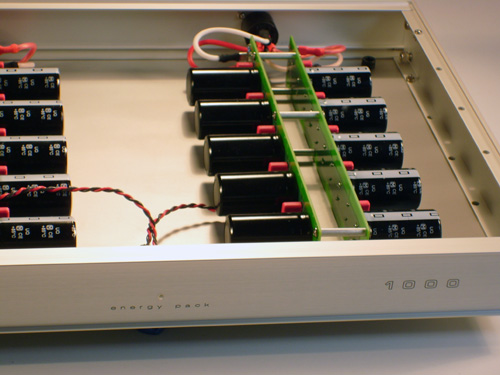
When I had everything hooked up correctly including the best of the cables I had on hand the ACG 1000 produced very stable images in a very wide soundstage. This was best heard on well-recorded classical albums such as the Mehta Planets on JVC XRCD or the SACD of the old Columbia recording of Copland's Appalachian Spring played by the New York Philharmonic and conducted by Bernstein. I could not get the same layered depth I get with my reference system, but this may be a system and cable matching issue. My sense is the ACG is quite sensitive to cable matching on both the input and output. Other reviewers have commented on the same thing with other class D amplifiers. It's unclear whether this is characteristic of the genre or just reflective of the limited experience reviewing such amplifiers.
I already mentioned the great midrange transparency of the 1000. Instrumental textures are portrayed beautifully and with utmost clarity, but without any exaggeration. Live recordings sound especially realistic and very revealing of the recording space. The only shortcomings I heard were in the highs again where some instruments were lacking in air and lucidness.
Most of my comments on the sound of the ACG 1000 Control Amp pertain to the direct connection of my CD/SACD player to the amplifier with no intervening preamp. This produced the widest soundstage, most transparent sound with detailed imaging and clarity. This configuration also provided the best connection with the music. With my tube preamp installed the sound was just a shade darker (a characteristic of this preamp) and transparency was reduced. Although dynamics were good, they were better with the direct connection. I had to use the preamp when playing LPs, which kept me from listening to that many LPs when reviewing this amp. Another problem I had, specific to my installation, is that the Audible Illusions preamp inverts phase. I normally correct this at the speaker, but doing so would have placed the CDs out of phase when switching to the CD player connected directly to the 1000. The phase inversion was clearly audible so I spent most of my time listening to CDs to keep things easier.
The ACG 1000 was enjoyable to listen to on all types of music, being it classical to rock or anything in between. I tended to listen to this amplifier played loud, to take advantage of all that extra power, but it could give a very nuanced and subtle performance when turned down low as well. It was a pleasure having the ACG 1000 in my house.
Summary
Several other Class D amplifiers have received good reviews in PFO, including the Kharma MP-150 and the various Nuforce designs. Not having heard those amps except at shows it's hard to place the ACG 1000 Control Amp in their context. It's the lowest cost measured in dollars per watt but not the cheapest in absolute terms. It's also not the fanciest looking nor does it have the best construction and parts quality, but it's built solidly and should hold up well in normal use.
The ACG 1000 Control amplifier is a great audio component but may not be for everyone. If you demand an amplifier with perfectly flat wideband frequency response you won't find it here as the lows are a bit boosted and the highs are a bit thin. If you want your audio rig to make a statement by virtue of its bulk or glamorous appearance then the ACG is not for you either. However, if you want almost limitless power or have a difficult speaker to drive then you should give it a listen. In particular if you like to immerse yourself deeply in the music to hear its drama and feel its emotion then you should definitely consider the ACG 1000. I bet the amplifier can be improved with further tweaking on cables, shielding, vibration and other matters. The ACG 1000 is also a tremendous bargain. For $3750 (plus $995 for the extra energy pack which is probably essential but can be added at any time) you receive not only a very powerful stereo amplifier, but also a passive control preamp with room for four inputs in the same package. Save the money on that exotic preamp and extra interconnects and invest instead in a good phono preamp and/or better source components. Unfortunately the ACG 1000 is only available via mail order so unless you know someone who has one it will be difficult to arrange an audition before buying. If in the market for a new amplifier I urge you to contact the Audio Crafters Guild and see what they can do to help. Highly recommended for the fun it brings to listening to a good audio system. Mike Wechsberg
1000 Control Amplifier
Retail: $3750
Audio Crafters Guild
web address:
www.audiocraftersguild.com
